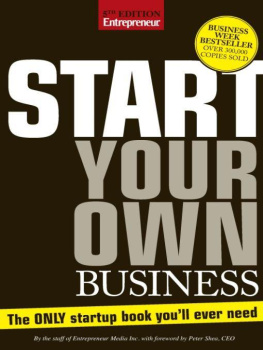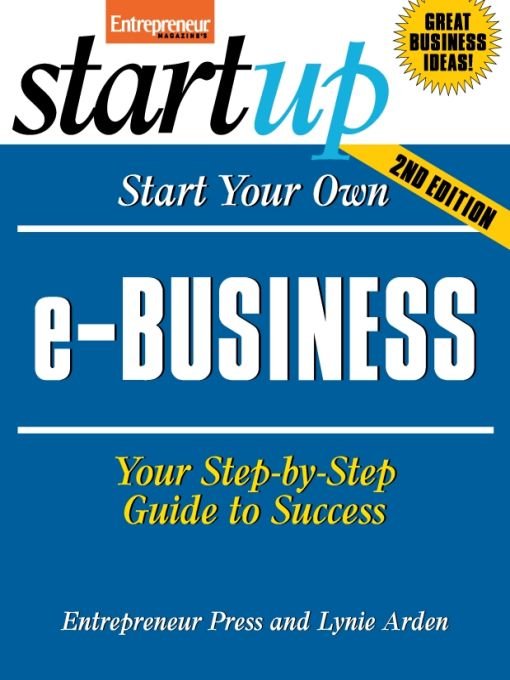Table of Contents
Additional titles in Entrepreneurs Startup Series
Start Your Own
Bar or Club
Bed & Breakfast
Business on eBay
Business Support Service
Car Wash
Child Care Service
Cleaning Service
Clothing Store
Coin-Operated Laundry
Consulting
Crafts Business
e-Learning Business
Event Planning Business
Executive Recruiting Service
Freight Brokerage Business
Gift Basket Service
Growing and Selling Herbs and Herbal Products
Home Inspection Service
Import/Export Business
Information Consultant Business
Law Practice
Lawn Care or Landscaping Business
Mail Order Business
Medical Claims Billing Service
Net Services
Personal Concierge Service
Personal Training Business
Pet-Sitting Business
Restaurant and Five Other Food Businesses
Self-Publishing Business
Seminar Production Business
Specialty Travel & Tour Business
Staffing Service
Successful Retail Business
Vending Business
Wedding Consultant
Wholesale Distribution Business
Preface
Like the mythical phoenix, the internet has risen from the ashes of the 2000 dotcom crash. This second surge, known as Web 2.0, continues to offer a virtual universe of opportunity. While venture capitalists and angels are more prudent about offering funding for dotcom startups, driven entrepreneurs with good ideas are still devising ways to build solid businesses that harness the power of the internet to reach millions of people worldwide.
Still, for every dotcom business that flourishes, hundredsmaybe thousandsgo bust. What does it take to build a dotcom that will succeed? Read this book and youll know, because in these pages youll find recipes for success, road maps that pinpoint the hazards, and dozens of interviews with dotcom entrepreneurs who have proved theyve got what it takes to survive in this sometimes fickle marketplace.
What separates the losers from the winners? Poor ideas, poor execution, poor marketing and poor funding.
Good ideas and smart business practices arent always enough, though. The internet has become crowded with companies that were online innovators and with traditional companies that reconfigured their operations to include an internet component. In some cases, launching a national, full-scale consumer-oriented site today may require millions to cover marketing, hardware, software and staffing costs. Gulp! Thats a big leap from the graduate school project days that gave rise to Yahoo.
Low-budget websites are still launching and making it to the big timesocial media phenom Facebook was born in a college dorm roombut now more than ever, they require a unique combination of customer insight, business understanding, technical know-how, financial resources and entrepreneurial drive. The possibilities of success remain enticing, even when wallets are thinif your ideas are smart and your execution persistent. The one inescapable fact is this: Its war on the monitors, and more websites will die than will survive. What will yours do?
The goal of this book is to give you the tools and knowledge youll need to emerge among the victors. In these pages, youll find the soup to nuts, the A to Z, of taking your idea through funding, building partnerships, launching, winning eyeballs and laughing all the way to the bank. This is not a technical book. Its a book about business and consumer psychology.
While the internets roots are in technology, that technology has become much more accessible to a wider group of entrepreneurs through the efforts and investment of many companies and people. Today, there better software tools that make it easier than ever for anyonetechnophobes includedto build and manage websites.
Well tell you what you need and where to get it, and for hard-core do-it-yourselfers, theres even a chapter on building your own website. Either way, theres no longer a reason to say I dont get this internet stuff. Youve got to get it, or get out of business.
Some words about how this book is organized: Interspersed among the chapters are Cheap Tricks, mini-interviews with low-budget website builders. The book also features interviews, called e-Chats, with CEOs of big-budget name-brand sitesamong them drugstore.com, Netflix.com, Proflowers.com, Autobytel.com, eBags.com and Zappos.com.
Youll also find three kinds of tip boxes designed to hammer home key points:
Smart Tip: bright ideas you want to remember as well as online opportunities
Beware!: pitfalls and potholes you want to avoid
Budget Watcher: money-saving ideas and practices
Heres the promise of this book: If you need to know it to do business online, youll find it between these covers. Read on to find out how to make your internet dreams a reality.
The Internet Gold Rush
This is ityour second chance to strike it very rich because once again, the internet is changing all the rules. The first dotcom gold rush occurred roughly between 1995 and 2001. It began when a little startup named Netscape introduced a web browserand the race for cash was on. Amazon, eBay, Yahoo, 1-800-Flowers.com, drugstore.com, Priceline.com, WebMD.comthey staked their claims to a piece of cyberspace and became billion-dollar businesses. Others, like Pets.com, WebVan and eToys, flamed out spectacularly when the bubble burst in 2001. Many wondered if the internet would ever amount to anything more than a few pie-in-the-sky ideas.
But today, e-commerce is back in a big way. Web 2.0 is here and many are referring to it as the second internet gold rush because so many new companies are once again making a big splash and changing the way people do business, spend time and purchase things online. Just as dotcom giants of the first wave did a decade ago, companies like Skype, YouTube, Facebook and Google are skyrocketing in value. And just as before, theyve all been started by smart individuals who have faith in their ideas and the future of the internet. They are succeeding because the new rules favor companies that are innovative, smart and ultraquick to react to changing consumer interests. It also helps that Web 2.0 entrepreneurs have been able to learn from the mistakes and successes of the original dotcom pioneers.
Chew on these numbers: Online retail sales are projected to hit $204 billion in 2008, up from $175 billion in 2007, and should reach $300 billion by 2013, according to a study conducted by Forrester Research, an independent technology and market research company. During the 2007 holiday season alone, consumers spent more than $29 billion online, an increase of 19 percent over the same period in 2006. On 2007s Green Mondaythe term eBay coined for the second Monday in Decemberonline sales hit a record of $881 million, making it the heaviest online spending day in history.
The internet is for real, and in the 21st century, if youre not on it, youre not in business. That is todays reality byte.







